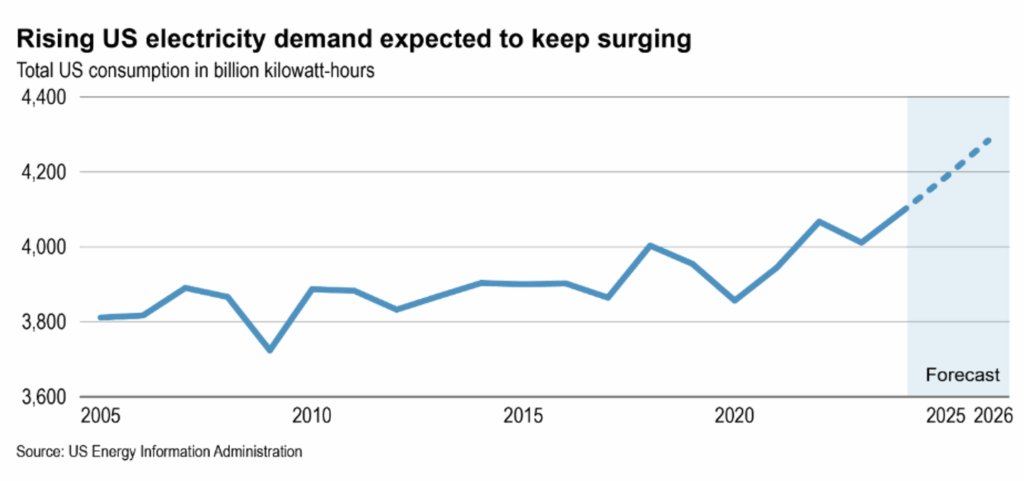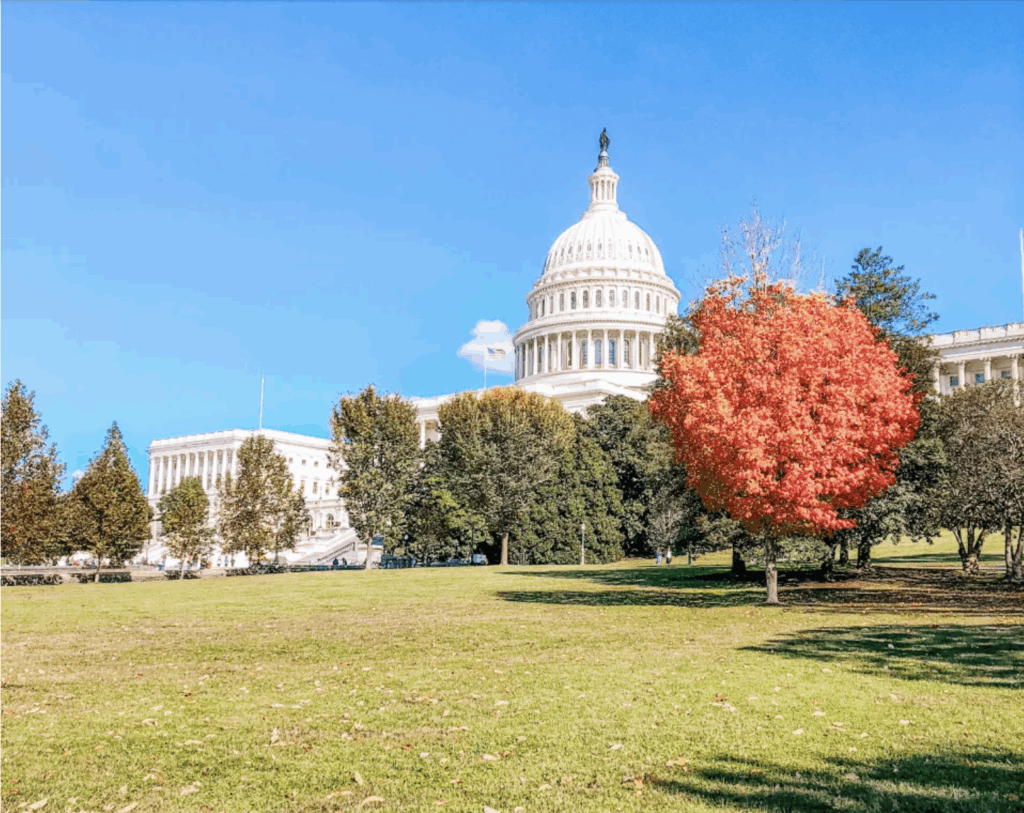Thought of the Week:
October 1 was a beautiful day in downtown Washington, D.C. There wasn’t a cloud in the sky, the temperature was a perfect 75 degrees, humidity was low at just 36%, and winds were light at 9 mph. What’s more, traffic was minimal, and I had my choice of seats on metro rides both to and from work. It was the kind of day that made one want to play hooky and get in a round of fall golf. October 1 was also the day the federal government shut down due to congressional inaction on passing FY 2026 appropriations legislation. It was the first federal shutdown since 2018, the twenty-first in modern U.S. history, and the third under President Trump. While past government shutdowns have been relatively mild affairs revolving around who was considered an “essential” or “nonessential” worker, in a break from precedent, rather than merely furloughing nonessential federal workers, the White House has threatened mass firings of government employees. At the same time, however, the Trump administration has vowed to continue the entirety of its trade work during the shutdown (see Inside U.S. Trade story below). That decision led me to look at how the Trump administration is doing in terms of achieving its trade targets. During House testimony, U.S. Trade Representative Greer outlined two measurable goals for trade policy: to reduce the trade deficit and to increase manufacturing as a share of GDP. In contrast to typically vague political slogans, the two metrics have official statistics by which they can be measured. So, more than eight months into President Trump’s second term, and six months since “Liberation Day,” how do things look? In short, the administration seems to be falling short of their objectives. Manufacturing’s share of GDP is smaller. The Commerce Department’s Bureau of Economic Analysis does an official ‘GDP by Industry’ estimate, and in its most recent release placed manufacturing’s share of GDP at 9.4% this year, down from 9.8% in 2024. Likewise, the U.S. trade deficit is bigger. The Census Bureau’s monthly tallies of U.S. trade flows show a goods-trade deficit of $840 billion so far this year (January to July), 23% larger than the $682 billion they reported January-July 2024. What’s more, for manufacturing specifically, this year’s $800 billion deficit outdoes last year’s $655 billion, and the larger goods/services balance of $654 billion is up about 30% from last year’s $500 billion. Although the higher 2025 deficit reflects, in part, a surge of imports in January, February, and March, as worried businesses stacked inventories before tariffs increased, since May, deficits have dropped somewhat. While Census’ most recent monthly deficit sum of $103.9 billion for July is in line with July 2024’s tally, this year’s total is certain to be larger than last year’s, and it remains a good bet that the One Big Beautiful Bill (OB3) will push up trade deficits again next year. In summary, Ambassador Greer’s metrics don’t look very good. In the few months since his Congressional testimony both metrics have gone in a clear direction, and it’s not the one the administration expected or wanted. To date, the Trump administration’s tariffs are failing to achieve their stated goals. Like much of official Washington sidelined during this shutdown, it might benefit the trade team to take a break and enjoy the fall weather.
Thought Leadership from our Consultants, Think Tanks, and Trade Associations
Eurasia Group Believes National Security Links and Direct Lobbying Will Shape Where Japanese Investment Commitments Go. The structure of the Investment Committee set to dictate investments made as part of the U.S.-Japan trade agreement gives Commerce Secretary Lutnick the power to pick and choose what companies and sectors benefit. Although President Trump will retain final decision-making authority, Secretary Lutnick and the White House will likely target industries broadly relevant to national security, including: semiconductors, pharmaceutical products (particularly antibiotics and generic medicines), metals, critical minerals, shipbuilding, energy (particularly LNG and nuclear power plant infrastructure), and AI. These sectors are also likely to see the federal government taking a direct equity stake in certain companies, although this subset of firms will likely be vastly smaller than those targeted for foreign direct investment. Given the huge amount of leeway granted to a small handful of decision makers, personal connections to the administration and effective lobbying will also play key roles in determining which initiatives get funded.
Inside U.S. Trade Reports that Trade Negotiations, Tariff Inquiries to Continue During Shutdown. The Trump administration is set to continue the bulk of its trade policy work during the government shutdown, according to agency-specific guides that say negotiations, tariff collections, and “national security” investigations are necessary parts of the President’s constitutional duties. Although agency functions deemed non-essential were suspended when federal appropriations lapsed at midnight on Oct. 1, there were exceptions for duties that officials have designated as necessary under either statutory mandates, the Constitution, or which are funded separately from the annual appropriations process. In fact, USTR Greer vowed that his office would be fully functioning during a funding lapse, and in the days leading up to the shutdown other agencies posted updated guidance allowing key trade operations to continue. The Commerce Department identified several functions as “necessary to the discharge of the President’s constitutional duties and powers,” including work on export controls, emergency export license applications, and Section 232 investigations. Commerce’s guidance also listed several International Trade Administration duties that would continue without appropriations; notably, functions supporting trade negotiations and import licensing. Tariff collections will also proceed as normal under the Homeland Security Department’s guide, specifically stating that “U.S. Customs and Border Protection revenue collections” will continue during a funding lapse. In addition, the USTR’s guide singles out President Trump’s executive orders imposing tariffs under the International Emergency Economic Powers Act. Work slated to shut down includes routine engagements with foreign trading partners, and all routine administrative functions beyond the minimum necessary to support the exempt activities. None of USTR’s 237 full-time equivalent staff will be furloughed. By contrast, the U.S. International Trade Commission’s guide says it would suspend most of its work on trade remedy investigations during a funding lapse.
Observatory Group Say Democrats Will Eventually Cave Over Shutdown and have Nothing to Show for It. The federal government was always almost certain to shut down at 12:01 a.m. on October 1. With no prospect of a quick reopening, this will be the first full shutdown since 2013, which lasted 16 days. Congressional Democrats remain entrenched in their demand that the premium tax credit (PTC) for ACA health insurance plans be extended, as their price for reopening the government. Republicans continue to rebuff any such provision being included in a government funding bill. The Trump administration is expected to make the shutdown politically painful for Democrats and blue states, using its broad authorities at the Office of Management and Budget (OMB). In fact, OMB has already drafted “guidance” for agency heads to implement reductions in force (RIFs), therefore making it likely that RIFs proceed more quickly than they did earlier this year (when implementation took several months). While many of the lay-offs would be reversed once the government reopens, agencies will be in the disadvantageous position of having to justify why federal workers must return to their positions rather than be fired, a dynamic that will likely result in larger reductions in staffing. The view inside D.C. is that the shutdown will likely last for two to three weeks, ending with a continuing resolution (CR) until mid-November and without acceding to Democrats’ demands. Although there should be minimal macro impact from the shutdown, unless it lingers for months on end, the most immediate impactful outcome would be a delay in federal data releases; even a macroeconomically insignificant shutdown could have knock on effects that delay data releases for the next several months as federal workers get up to speed.
“Inside Baseball”
Politico Reports on the Widening Export Control Net. The Commerce Department plans to automatically add subsidiaries of previously targeted foreign entities to a U.S. trade blacklist. The move contained in an interim final rule is aimed at preventing firms in China and other countries from bypassing Washington’s export controls. It broadens the so-called entity list to cover subsidiaries that are at least 50% owned by listed companies, significantly expanding the number of firms on the blacklist, according to a published Federal Register notice. The rules, while applied broadly, are primarily seen as targeting China’s technology sector, since many of its firms appear on the so-called military end-user list due to activities the U.S. views as potentially supporting the military of a hostile nation. As a result of the measure, companies seeking to do business with firms on the entity list will have to apply for licenses to receive U.S. goods and technology. Public comments for the policy update, which could still be revised, are open for 30 days.
In Other Words
“We can’t let people throw around that word. I call it the n-word. There are two n-words, and you can’t use either of them,” President Trump discussing nuclear submarines.
“I told them, ‘You didn’t get me elected. I do not work for you; I work for my district.’…‘We aren’t supposed to just be whipped on our votes because they’re telling us what to do with this scary threat, or saying ‘We’ll primary you,’ or that we won’t get invited to the White House events,’” Rep. Marjorie Taylor Greene (R-GA) recounting her disagreements with the Trump administration.
Did You Know
The Wheaton, MD, D.C. metro stop has the longest single span escalators in the western hemisphere.
Graphs of the Week
Rising Electricity Costs Unlikely to Change Trump Administration’s Energy Policy. The Trump administration has launched an effort to scale back federal support for wind and solar projects. The White House is unlikely to reverse this approach. In fact, administration officials have several political and strategic reasons to adopt this position, and those priorities will outweigh economic concerns. While moves that limit new electricity capacity development or raise its costs may contribute to rising electricity prices, especially as the tech sector drives historic growth in electricity demand, the administration wants the deregulation of fossil fuels to largely fill the gap; however, supply chain bottlenecks are likely to keep new gas-fired power from coming online fast enough to compensate. Estimates suggest demand growth could double or triple from the less-than-1% annual growth rates common during the past 25 years. What’s more, significant increases in consumer bills may not cause enough public backlash to influence policy.

